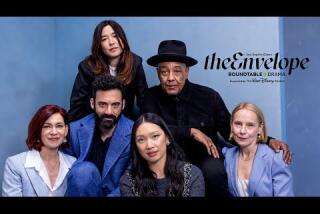Playing Sick : Actors Who Feign Illnesses Take a Leading Role in Training Doctors-to-Be
The pretty young woman sobs as the medical student gently pricks her torso with a straight pin, testing for loss of sensation.
“What’s wrong with me?” the patient pleads, her anxiety almost palpable. Stretched out on an examining table at County-USC Medical Center, she nervously answers the student’s questions. This morning, she tells him, she awoke to find she couldn’t move her legs. “I’ll be able to walk again, won’t I?” she asks.
But Patti Dugger, the frightened woman being probed and prodded, is not really a patient. She is actress Parker McPhinney, one of a small but growing number of performers whose venues include medical schools as well as theater, TV and movies.
Known in medical education circles as a “standardized patient,” McPhinney uses her acting skills to teach medical students how to be better doctors. Because of actors such as McPhinney, doctors-to-be at USC, UCLA and dozens of other schools are mastering skills often neglected in traditional training, from how to spot a cocaine addict to how to take a probing but sensitive sexual history.
Even though the students who gather around McPhinney have been told she is not a real patient, they typically forget that this is medical theater as they focus on the problem at hand.
The sharpest of the students will deduce that McPhinney, who has been cast and coached by experts, has multiple sclerosis. But their teachers hope they will learn other important lessons as well, such as how to extract reliable information from a terrified person who doesn’t know what is medically relevant.
“I think working with standardized patients is one of the waves of the future,” says Stephen Abrahamson, retired head of medical education at USC and co-author in 1964 of the first scientific article on the use of standardized patients. “I predict that by the year 2005 or 2010, almost all medical schools will have them for teaching and evaluation.”
In Los Angeles, medical educators, like restaurant owners, can dip into the world’s largest pool of underemployed acting talent. Take McPhinney, a 30-year-old Echo Park resident whom some regard as the Meryl Streep of medical actors.
Three or four times a year, McPhinney, who supports herself as an artist’s model, gets an industry acting job. Her recent credits include TV’s “Star Trek: The Next Generation.” But even when her agent doesn’t call for weeks at a time, McPhinney is a star at local medical schools.
There are now more than 50 roles, all based on real cases, in the growing medical repertoire, according to Peggy Wallace, the USC staff member who recruits and trains most of the local performers.
Patti Dugger is the oldest and choicest of them, the Lady Macbeth of medical roles.
“Patti is my favorite role because it’s so challenging,” McPhinney says. “It’s such a layered piece.” Patti has no line-by-line script, which means that McPhinney must constantly improvise, responding to the students’ unpredictable behavior while staying in character.
The role is also extremely demanding physically. McPhinney has trained her abdominal muscles not to tighten up when the examiner scratches the skin on either side of her navel. She has learned how to make her leg hyper-react to an examiner’s thump by tensing her shoulder muscles. And she has mastered the abnormal Babinski reflex of a multiple sclerosis sufferer, fanning her toes up and out when an examiner scratches her heel or touches a pin to her big toe.
McPhinney has stayed in character even when an overzealous student drew blood with his straight pin.
To play one of the standardized patient roles, actors have to wear yellowish makeup to simulate jaundice. Another part involves secretly modifying the student’s blood-pressure gauge so the patient appears on the verge of a stroke. But McPhinney prefers the roles that depend for their success on acting ability alone.
Although only a few physicians and students see any given performance, McPhinney prepares as if she were playing Broadway. She does the “interior work” typical of the Method school of acting, building her character from the inside out. McPhinney says she has a clear picture of Patti’s relationship with her boyfriend--a fussily neat carpenter whom Patti met in a Laundromat--even though “Eddie” is hardly mentioned in the 14-page description of Patti given to those being trained to play the part.
“I create a whole psyche for her that is never seen or brought out but that I need to make the character three-dimensional,” McPhinney says.
Abrahamson, who with former USC colleague Howard Barrows pioneered the use of such actors, explains that medical students have traditionally practiced almost exclusively on ailing people--a situation that puts enormous stress on both patient and student.
“Wouldn’t it be better,” Abrahamson asks, “if you did it the way they do it in pilot training, on a simulator?”
Much like a flight simulator, the actor-patient provides the student with a safe but realistic opportunity to master the basics, with no risk that either patient or student will crash and burn, he says.
According to Barrows, now on the medical faculty at Southern Illinois University, simulation is especially valuable when students are learning such emotionally charged lessons as how to tell someone that he or she has a terminal illness, or how to handle an emergency.
“So much of medical education is random, but with standardized patients, you can ensure that every student is exposed to a particular case,” says Stuart Slavin, a UCLA pediatrics professor and medical educator. Slavin says standardized patients will be an integral part of UCLA’s new medical school curriculum. He and Michael Wilkes, head of the new program, met recently with actress Jill Eikenberry and actor Richard Masur for advice on training their actor patients.
McPhinney’s medical center gigs aren’t going to make her famous or rich. She and the approximately 60 other medical actors in the area make $25 an hour or less. But, she says, “there’s nothing worse than being an actor and playing some stupid bimbo role that doesn’t relate to anything. This goes beyond entertainment. I feel like I’m helping society.”
Almost three decades after Barrows proposed using someone with acting ability to pretend to be a particularly edifying neurological patient, the idea is finally taking hold.
“Initially, the hostility toward it was enormous,” he says. “Until you see it, it sounds like Barnum & Bailey, not real medicine.” Now, he says, just a brief demonstration is enough to convert most skeptics.
The first standardized patient was an artist’s model named Rosemary--Barrows says he never knew her last name--whom he found through the USC art department. He reasoned, in that more innocent time, that an artist’s model was one of the few people who wouldn’t blush at the prospect of dropping her hospital gown in a room full of medical students.
These days, USC’s Wallace finds candidates for standardized patients through word of mouth. Her performers include several teen-agers from Van Nuys High School for the Performing Arts who were recommended by their acting teacher.
The use of actors is also burgeoning in the formal assessment of medical students. Next year the National Board of Medical Examiners will test a clinical competence examination in which students will be asked to evaluate a series of standardized patients.
If the performance of the patient stays the same, the theory goes, it becomes easier to make distinctions about how effectively different students deal with the situation.
Even though McPhinney knows she’ll never win an Oscar playing Patti Dugger, she continues to endure cold hands and pinpricks for her socially meritorious art.
“I didn’t come to planet Earth to play a hooker,” says McPhinney, explaining the lure of medical theater--which is not to say she wouldn’t hang up her backless hospital gown if the right offer came along.
“Of course,” she adds, “if Alan Parker called me up and asked me if I wanted to play a hooker in his next film, I wouldn’t hesitate to say, ‘Sure. How short do you want the skirt?’ ”


